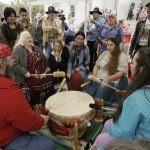Western Abenaki Language and the Saint Lol River
A “people of the dawnlands” (where the sun rises), who speak something called Abenaki, shave distinct portions of their heads, resort to fishing and were confronted with European colonialism resembles a culture from feudal Japan. Instead, they are an Indian tribe native to southern Quebec, Maine, and Vermont around the Saint Laurence river. Historically they differ significantly from their Japanese counterparts by their heavy participation in the fur trade (slightly warmer than a kimono). Their complicity with the French in this business brought about an alliance during the French and Indian war during which the tribe sustained heavy losses. Fast forward today where the impending loss may be the language which has less than one hundred speakers left.
Abenaki is an Eastern Algonquian language, a language group which has representatives on the East and West coasts! While this geographical spread might suggest a Pan-American language, the differences in style and vocabulary lead to even Abenaki being divided into two sub-groups, Western and Eastern. The Western branch will be discussed because the Eastern branch (mostly in New England) has disappeared. A philosophical side note might be the absurdity that cultures of conservation are least likely to be conserved. Interestingly, the ecological wigwam, the integral use of an animal carcass, the profound respect for nature are very apparent in Abenaki grammar. Characteristic of Algonquian is a class of nouns for animate things or people and one for inanimate objects. For example, “senal” (stones) are inamimate and “kaozak” (cows) are animate where –al and –ak are the appropriate plural endings, depending on class. However, also qualified as animate is a tree, possibly from respect for this oxygen provider. Whereas English only has the words “tree” or “sapling”, Abenaki contains Msoakw (dry tree), Temanakw (broken tree), Alômakuam (heart of a tree), among others, and contains eight words for “moose”. Credit to Chief Joseph Laurent, creator of an 1884 dictionary that translates towards English (very important for Abenaki-specific words) and his son Stephen who brought to life a faded early-18th century manuscript from a French missionary, Father Aubery.
Modern study is by Emon Bach from the University of Massachusetts who exposes a marked difference with other Algonquian languages and similarity with English in the distinction between b and p, d and t, or z and s, appropriately called voiced and voiceless sounds. Bach also states the only oddity in written Abenaki is the inclusion of a letter ô (also written “ȣ”), effectively a nasal vowel. And unlike English when an umlaut comes up every 100 pages or so, “ô” is quite common as in “ôhô” (yes). Bach’s cataloguing of the Abenaki language is a great resource with simple terminology. Every verb form is explored from subjective to past negative. Yet if past negative is not entertaining enough, maybe the translation of certain European names into Abenaki is. Saint Lawrence who gave his name to the local river would have been named “Saint Lol” (comical for those familiar with internet terminology). Otherwise some examples include Peter becoming “Pial”, Edward to “Edoal”, Michael to “Missal”, and Charlotte to “Sallot”. It would be interesting to explore the birth records of St. François-du-Lac, the Canadian community with the most Abenaki tribesmen.
Linguistic reservation efforts in Canada regretfully rely mostly on the large amounts of literature and traditional songs and feasts. However, in the United States, maybe as a last-ditch effort, Abenaki is finally entering education. Abenaki-Penobscot has an after-school program, summer immersion camp, and a computerized primer. Additionally, grants from New England colleges are allowing more research which has already contributed to a full recording of the language’s vocabulary and pronunciation. Abenaki is one of the languages most deserving survival. The grammar allows all types of expression, the writing system is modern, they are temperate with alcohol, docile, not profane, and their history is implanted in the Champlain valley region, as well as Europe. Indeed, a wampum necklace was given to the cathedral of Chartres, France and twenty four tribesmen visited England as early as 1614, albeit in captivity. The real conclusion is that the only acceptable captivity in this modern time is the language’s heritage captive in the minds of bright young pupils.

Category: Foreign Language








